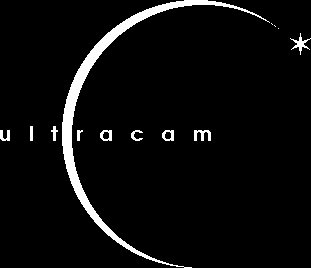Vik Dhillon (University of Sheffield), Tom Marsh (University of
Southampton) and the ULTRACAM team*
*UKATC: Andy Vick, David Atkinson, Tully Peacocke, Steven Beard,
Stewart McLay, David Lunney, Chris Tierney, Derek Ives
Southampton: Carolyn Brinkworth
Sheffield: Mark Stevenson, Paul Kerry, William Feline,
John Kelly, Richard Nicholson, Richard French, Richard Pashley, Paul
Kemp-Russell
ULTRACAM was successfully commissioned on the WHT on 16 May 2002, over
3 months ahead of schedule and within budget. The instrument was funded by
PPARC and designed and built by a consortium involving the
Universities of Sheffield, Southampton and the UKATC, Edinburgh.
ULTRACAM is a high-speed, three-colour CCD camera designed to provide
imaging photometry at high temporal resolutions. The instrument is
highly portable and will be used at a number of large telescopes
around the world. On the WHT, ULTRACAM mounts at the Cassegrain focus
and provides a 5 arcminute field on its three 1024x1024 CCDs (i.e. 0.3
arcseconds/pixel). Incident light is first collimated and then split
into three different beams using a pair of dichroic beamsplitters.
One beam is dedicated to the SDSS u' filter, another to the SDSS g'
filter and the third to the SDSS r'/i'/z' filters, although it is
possible to use different filters if required. By careful selection
of glasses and coatings on the optics and chips, we have achieved an
instrumental throughput of approximately 50% in the green and red arms
of ULTRACAM and 30% in the blue arm. Combined with the fact that
ULTRACAM mounts at Cassegrain, and hence telescope losses are minimal,
we obtain a count rate of approximately 2000 per second for a V=18
magnitude star in the V-band.
The CCDs in ULTRACAM are E2V 47-20 frame-transfer devices of
exceptional cosmetic quality (grade 0) and quantum efficiency (97% at
peak). The chips are Peltier and water-cooled to 233 K, giving
approximately 0.05 electrons/pixel/second dark current. This figure is
much less than the faintest sky recordable with the WHT and hence dark
current is an insignificant noise source with ULTRACAM. The readout
noise of the chips is also remarkably low - just over 3 electrons
when reading out at 10 microseconds/pixel and just under 6 electrons
when reading out at 2 microseconds/pixel.
There is a great deal of flexibility in the configuration of the
ULTRACAM chips. It is possible to read the chips out in full-frame
mode without clearing (for minimum dead-time), full-frame mode with
clearing (for minimum exposure times), two-windowed mode,
four-windowed mode, six-windowed mode and drift mode (for maximum
frame rate). In each of these modes, it is possible to alter the size
of the windows, the positions of the windows, the binning factors, the
pixel digitisation speed, the gain and the clock speeds. Each image
taken by ULTRACAM is also time-stamped using a dedicated GPS system to
an accuracy of better than 0.1 milliseconds.
Because ULTRACAM employs frame-transfer chips, the dead-time between
exposures depends only on the vertical clocking time and is hence
negligible; for the full-frame and windowed modes the dead-time is
typically 25 milliseconds and in drift mode it falls to a fraction of a
millisecond. The maximum frame rate of ULTRACAM depends on the sizes
of the windows being read out; using drift mode and two small windows
it is possible to achieve frame rates of up to 300 Hz. To handle such
huge data rates (up to 3.6 Mbytes/second, i.e. up to 200 Gbytes/night),
ULTRACAM uses a RAID array to store the data, a DDS4 drive to archive
the data and, most importantly, a pipeline data reduction system to
enable real-time assessment and full reduction of the light curves.
A key driver during the design of the instrument hardware and software
has been simplicity, which ensures that the instrument is as reliable,
portable and upgradeable as possible. Therefore, the instrument has no
moving parts and the CCDs are read out using an SDSU controller (such
as the ones used on the common-user instruments at the ING) connected
to a linux PC via a PCI interface. Furthermore, the astronomer
controls the CCD cameras using http requests sent via a standard web
browser, enabling ULTRACAM to be operated remotely over the internet.
ULTRACAM has now been used for a total 5 nights in May 2002 (1 night
commissioning and 4 nights PATT science) and 13 nights in September
2002 (4 nights PATT science, 6 nights NL science and 3 nights CAT
science). The instrument is working to specification and appears to be
very reliable - we lost only 30 minutes in 13 nights in September 2002
to technical downtime, which was due to a faulty off-the-shelf ethernet card.
The instrument has so far been used to observe a wide range of
astrophysical targets at high temporal resolution, including pulsars,
eclipsing binary stars, cataclysmic variables, black-hole X-ray
binaries, neutron-star X-ray binaries and asteroseismology. Some of the initial
results from these runs are presented in the accompanying figures.
For more detailed information on ULTRACAM, including on-line
signal-to-noise and frame-rate calculators, please consult the
instrument web pages at
http://www.shef.ac.uk/~phys/people/vdhillon/ultracam. If you are
interested in using ULTRACAM on a collaborative basis, please contact
Vik Dhillon (vik.dhillon@shef.ac.uk) or Tom Marsh
(trm@astro.soton.ac.uk).
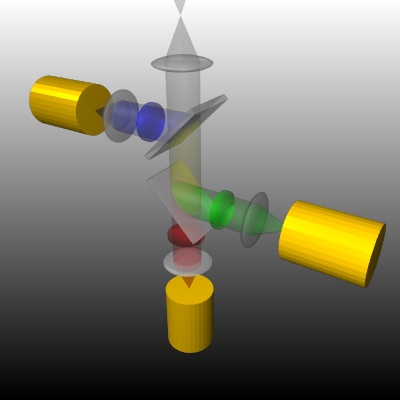
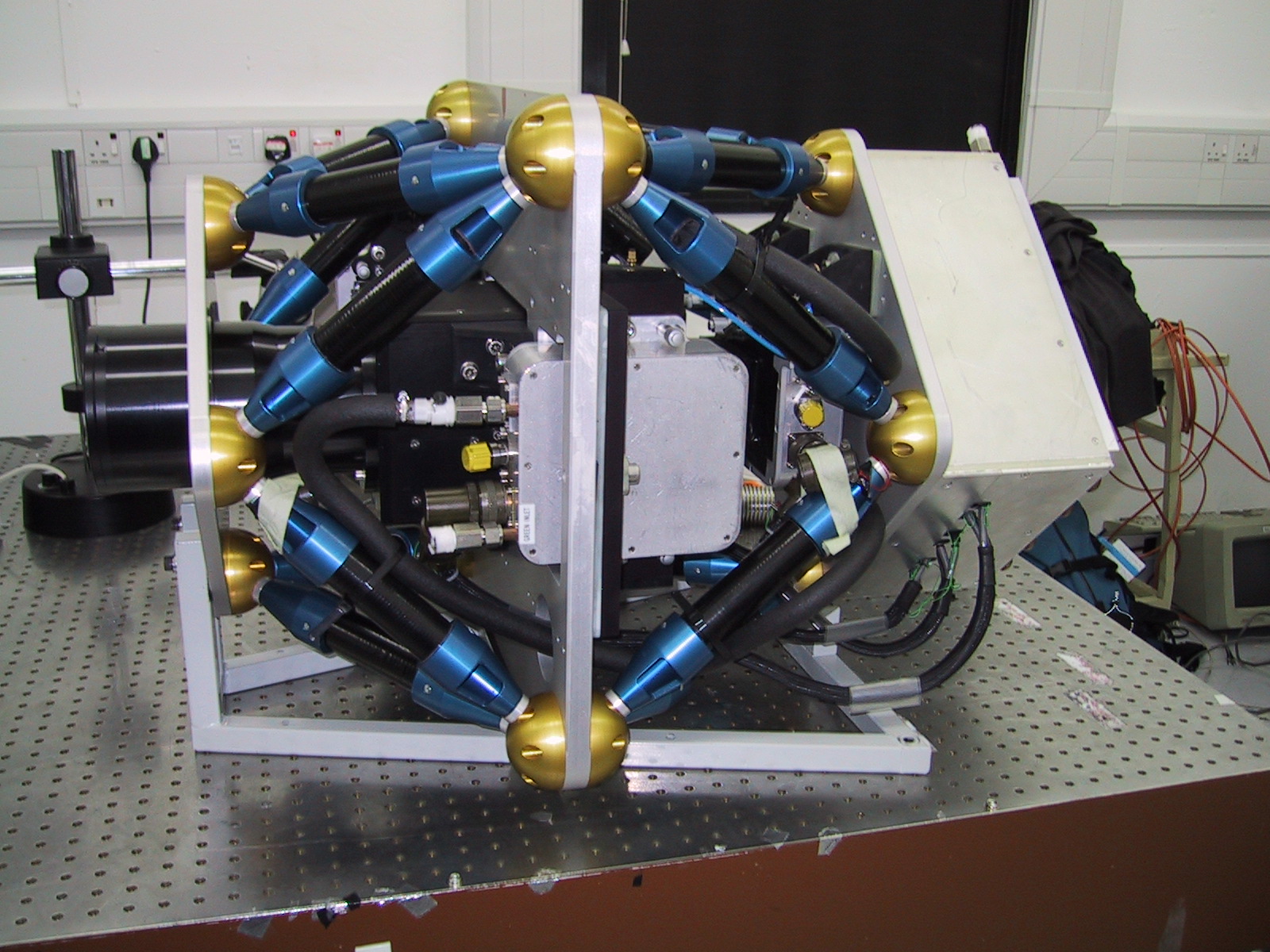
Left: Schematic showing the light path through ULTRACAM. Right:
ULTRACAM in the test focal station at the WHT, just prior to mounting
on the telescope (courtesy Sue Worswick).
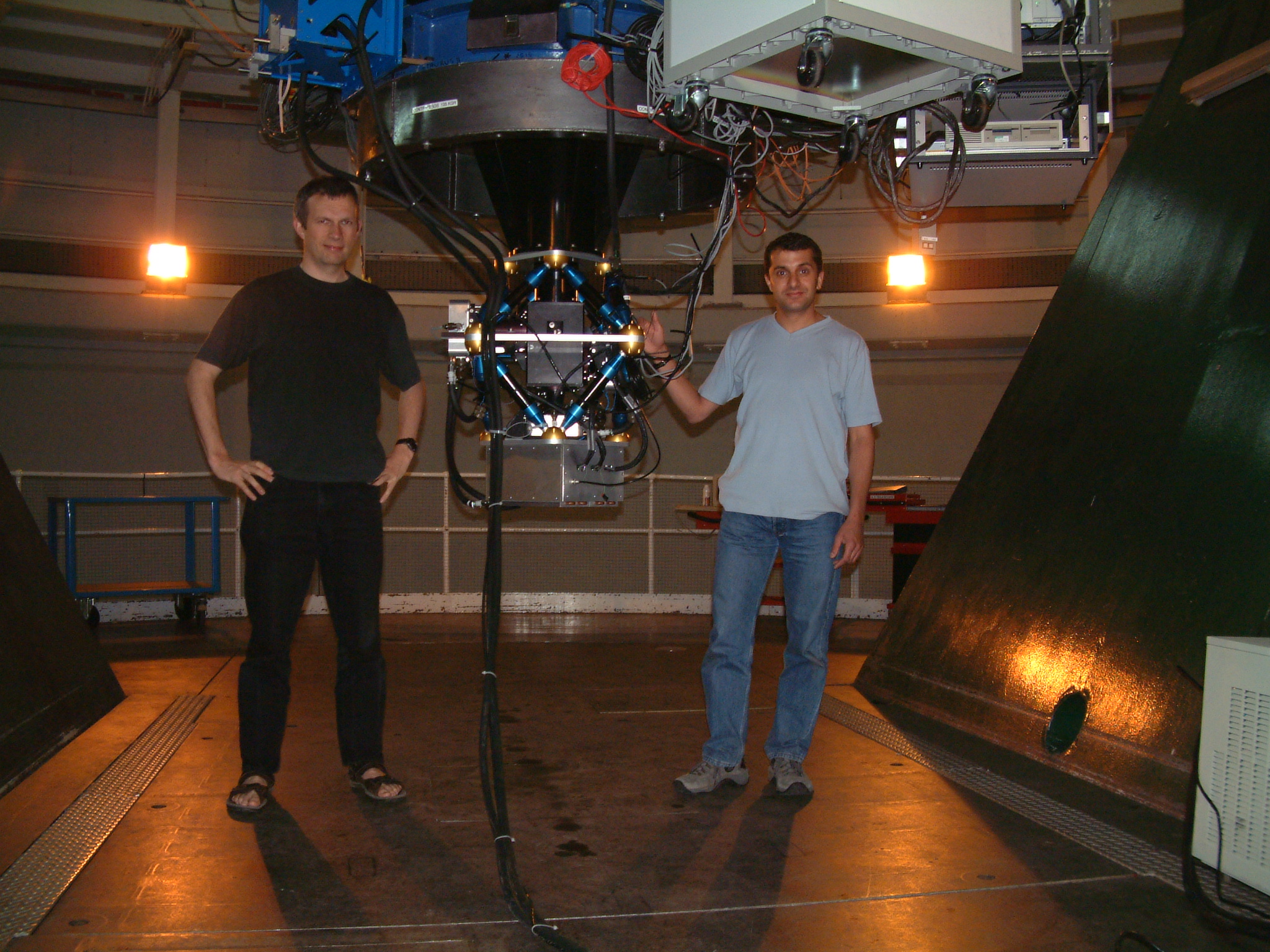
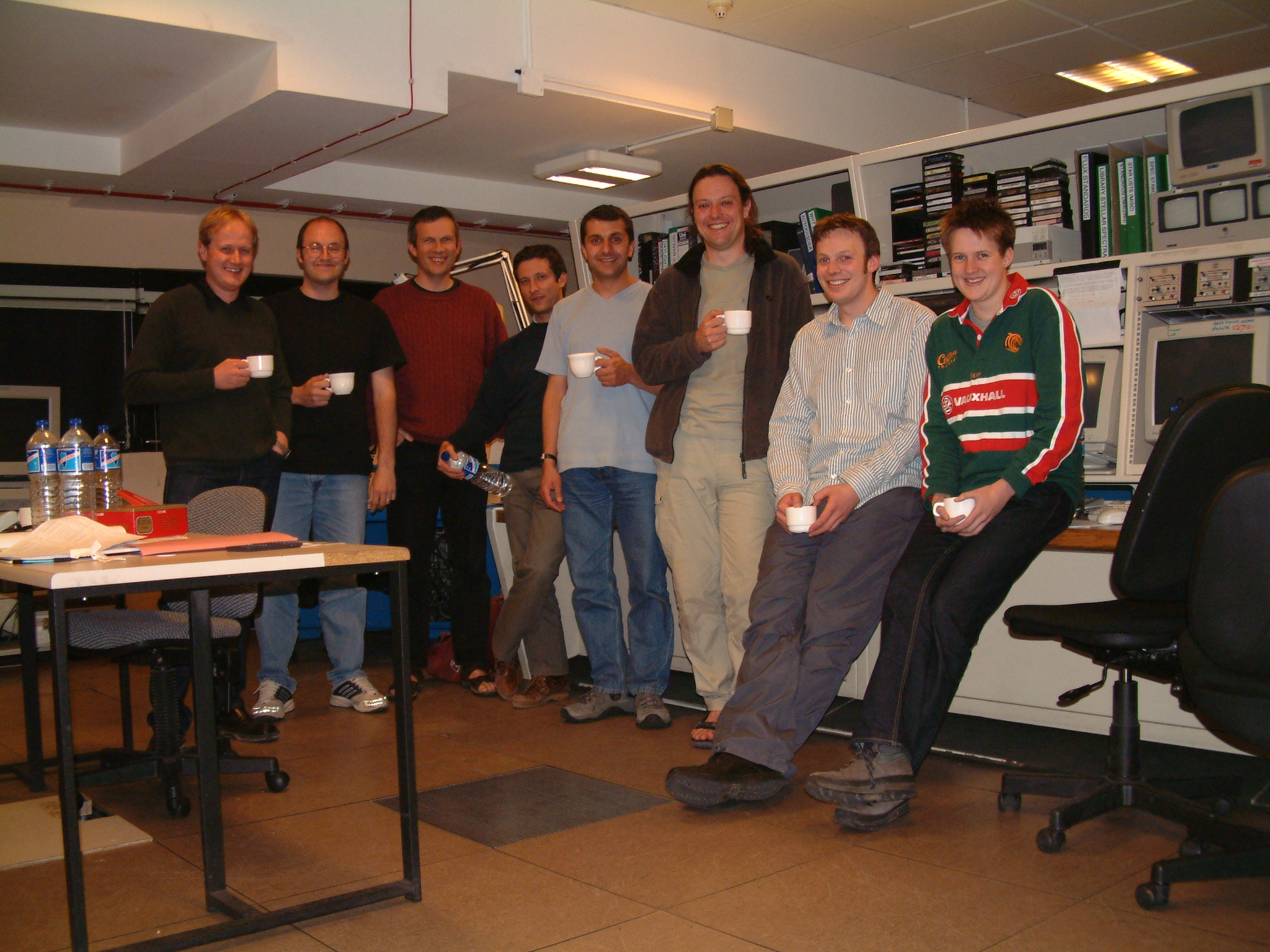
Left: ULTRACAM mounted on the Cassegrain focus of the WHT. Right: The
ULTRACAM commissioning team (from left-to-right: Mark Stevenson
(Sheffield), Paul Kerry (Sheffield), Tom Marsh (Southampton), Marco
Azzaro (ING), Vik Dhillon (Sheffield), Andy Vick (UKATC), David
Atkinson (UKATC), Carolyn Brinkworth (Southampton).
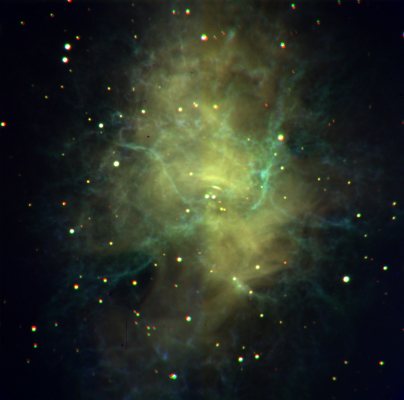
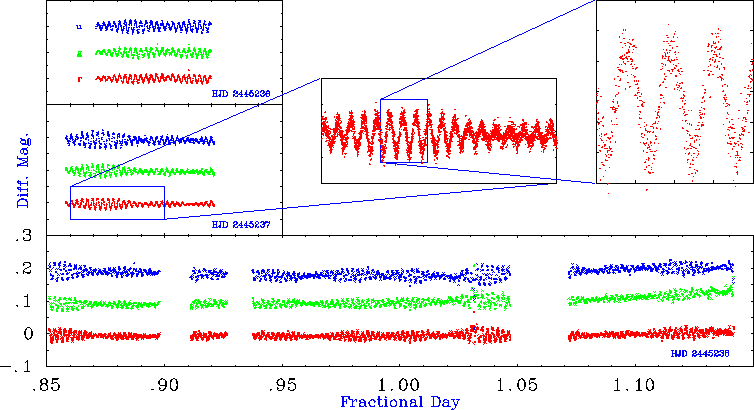
Left: Image of the Crab Nebula, obtained by combining the simultaneous
u', g' and r' ULTRACAM images. Fast data on the crab pulsar at the
centre of this image were obtained in order to calibrate the accuracy
of the ULTRACAM GPS time-stamping. Right: Light curve of the pulsating
sdB star KPD2109+4401 obtained by Simon Jeffery (Armagh) for use in
his ULTRACAM asteroseismology project.
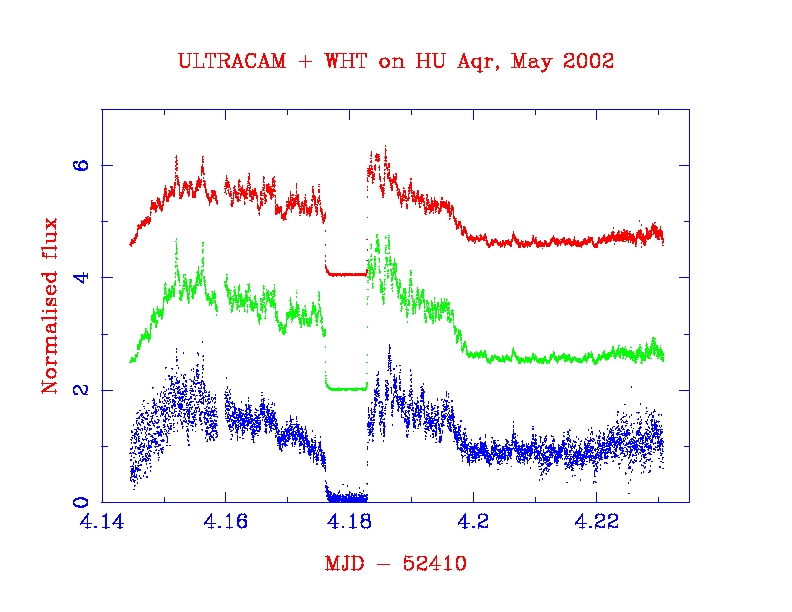
Light curve of the eclipsing polar HU Aqr, which consists of a white
dwarf accreting material onto its magnetic poles from a red dwarf companion
star. The light curve shows intense flickering from the accreting poles
and the eclipse of the poles (the 2-3 second transition into eclipse).
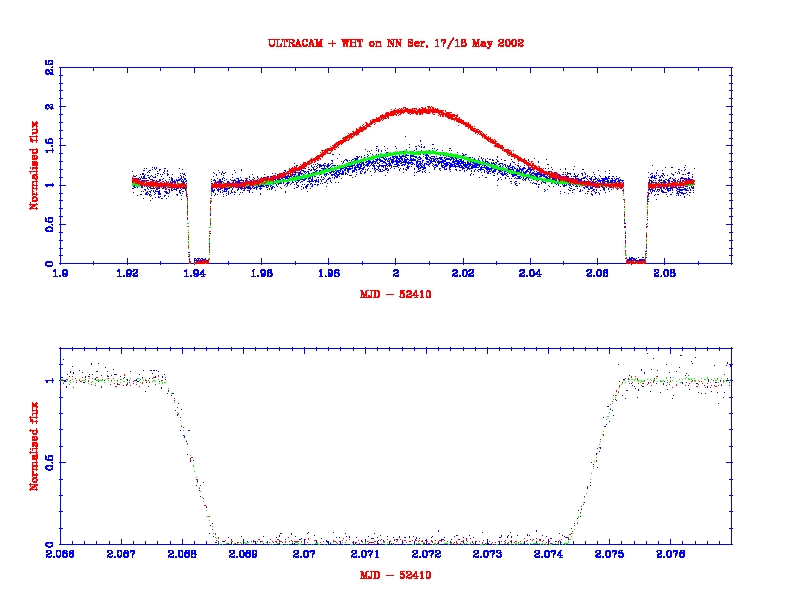
Light curve of the eclipsing white-dwarf/red-dwarf binary NN Ser. Each
point on the graph represents a 2 second exposure. The upper panel
shows the u', g' and r' flux versus time. The rise in the centre of
the curve is due to a reflection effect, where the irradiated inner
hemisphere of the cooler star comes into view. The lower panel is an
expanded plot of the eclipse. The eclipse is due to the obscuration of
the hot white dwarf by the cool red dwarf and will be used to measure
the masses and radii of the two stars (using a full light curve fit)
and the rate at which the orbital period of the binary is decreasing.
ULTRACAM is a high-speed, three-colour CCD camera designed to provide imaging photometry at high temporal resolutions. The instrument is highly portable and will be used at a number of large telescopes around the world. On the WHT, ULTRACAM mounts at the Cassegrain focus and provides a 5 arcminute field on its three 1024x1024 CCDs (i.e. 0.3 arcseconds/pixel). Incident light is first collimated and then split into three different beams using a pair of dichroic beamsplitters. One beam is dedicated to the SDSS u' filter, another to the SDSS g' filter and the third to the SDSS r'/i'/z' filters, although it is possible to use different filters if required. By careful selection of glasses and coatings on the optics and chips, we have achieved an instrumental throughput of approximately 50% in the green and red arms of ULTRACAM and 30% in the blue arm. Combined with the fact that ULTRACAM mounts at Cassegrain, and hence telescope losses are minimal, we obtain a count rate of approximately 2000 per second for a V=18 magnitude star in the V-band.
The CCDs in ULTRACAM are E2V 47-20 frame-transfer devices of exceptional cosmetic quality (grade 0) and quantum efficiency (97% at peak). The chips are Peltier and water-cooled to 233 K, giving approximately 0.05 electrons/pixel/second dark current. This figure is much less than the faintest sky recordable with the WHT and hence dark current is an insignificant noise source with ULTRACAM. The readout noise of the chips is also remarkably low - just over 3 electrons when reading out at 10 microseconds/pixel and just under 6 electrons when reading out at 2 microseconds/pixel.
There is a great deal of flexibility in the configuration of the ULTRACAM chips. It is possible to read the chips out in full-frame mode without clearing (for minimum dead-time), full-frame mode with clearing (for minimum exposure times), two-windowed mode, four-windowed mode, six-windowed mode and drift mode (for maximum frame rate). In each of these modes, it is possible to alter the size of the windows, the positions of the windows, the binning factors, the pixel digitisation speed, the gain and the clock speeds. Each image taken by ULTRACAM is also time-stamped using a dedicated GPS system to an accuracy of better than 0.1 milliseconds.
Because ULTRACAM employs frame-transfer chips, the dead-time between exposures depends only on the vertical clocking time and is hence negligible; for the full-frame and windowed modes the dead-time is typically 25 milliseconds and in drift mode it falls to a fraction of a millisecond. The maximum frame rate of ULTRACAM depends on the sizes of the windows being read out; using drift mode and two small windows it is possible to achieve frame rates of up to 300 Hz. To handle such huge data rates (up to 3.6 Mbytes/second, i.e. up to 200 Gbytes/night), ULTRACAM uses a RAID array to store the data, a DDS4 drive to archive the data and, most importantly, a pipeline data reduction system to enable real-time assessment and full reduction of the light curves.
A key driver during the design of the instrument hardware and software has been simplicity, which ensures that the instrument is as reliable, portable and upgradeable as possible. Therefore, the instrument has no moving parts and the CCDs are read out using an SDSU controller (such as the ones used on the common-user instruments at the ING) connected to a linux PC via a PCI interface. Furthermore, the astronomer controls the CCD cameras using http requests sent via a standard web browser, enabling ULTRACAM to be operated remotely over the internet.
ULTRACAM has now been used for a total 5 nights in May 2002 (1 night commissioning and 4 nights PATT science) and 13 nights in September 2002 (4 nights PATT science, 6 nights NL science and 3 nights CAT science). The instrument is working to specification and appears to be very reliable - we lost only 30 minutes in 13 nights in September 2002 to technical downtime, which was due to a faulty off-the-shelf ethernet card. The instrument has so far been used to observe a wide range of astrophysical targets at high temporal resolution, including pulsars, eclipsing binary stars, cataclysmic variables, black-hole X-ray binaries, neutron-star X-ray binaries and asteroseismology. Some of the initial results from these runs are presented in the accompanying figures.
For more detailed information on ULTRACAM, including on-line signal-to-noise and frame-rate calculators, please consult the instrument web pages at http://www.shef.ac.uk/~phys/people/vdhillon/ultracam. If you are interested in using ULTRACAM on a collaborative basis, please contact Vik Dhillon (vik.dhillon@shef.ac.uk) or Tom Marsh (trm@astro.soton.ac.uk).


Left: Schematic showing the light path through ULTRACAM. Right: ULTRACAM in the test focal station at the WHT, just prior to mounting on the telescope (courtesy Sue Worswick).
Left: ULTRACAM mounted on the Cassegrain focus of the WHT. Right: The ULTRACAM commissioning team (from left-to-right: Mark Stevenson (Sheffield), Paul Kerry (Sheffield), Tom Marsh (Southampton), Marco Azzaro (ING), Vik Dhillon (Sheffield), Andy Vick (UKATC), David Atkinson (UKATC), Carolyn Brinkworth (Southampton).


Left: Image of the Crab Nebula, obtained by combining the simultaneous u', g' and r' ULTRACAM images. Fast data on the crab pulsar at the centre of this image were obtained in order to calibrate the accuracy of the ULTRACAM GPS time-stamping. Right: Light curve of the pulsating sdB star KPD2109+4401 obtained by Simon Jeffery (Armagh) for use in his ULTRACAM asteroseismology project.

Light curve of the eclipsing polar HU Aqr, which consists of a white dwarf accreting material onto its magnetic poles from a red dwarf companion star. The light curve shows intense flickering from the accreting poles and the eclipse of the poles (the 2-3 second transition into eclipse).

Light curve of the eclipsing white-dwarf/red-dwarf binary NN Ser. Each point on the graph represents a 2 second exposure. The upper panel shows the u', g' and r' flux versus time. The rise in the centre of the curve is due to a reflection effect, where the irradiated inner hemisphere of the cooler star comes into view. The lower panel is an expanded plot of the eclipse. The eclipse is due to the obscuration of the hot white dwarf by the cool red dwarf and will be used to measure the masses and radii of the two stars (using a full light curve fit) and the rate at which the orbital period of the binary is decreasing.
